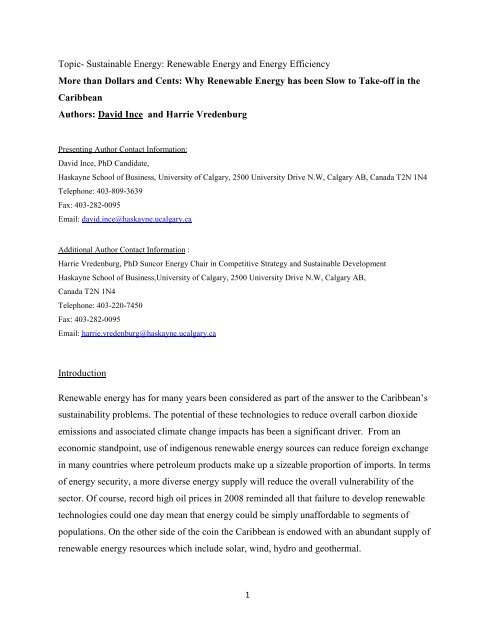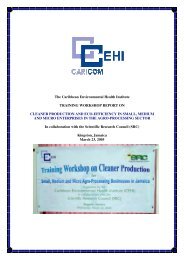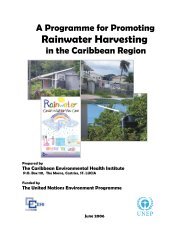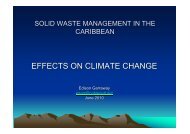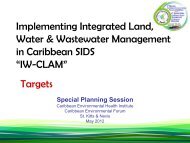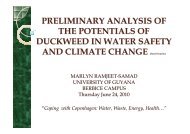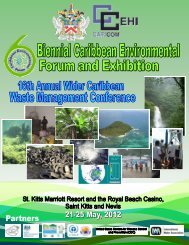David Ince More than Dollars and Cents Why Renewable Energy has ...
David Ince More than Dollars and Cents Why Renewable Energy has ...
David Ince More than Dollars and Cents Why Renewable Energy has ...
Create successful ePaper yourself
Turn your PDF publications into a flip-book with our unique Google optimized e-Paper software.
Topic- Sustainable <strong>Energy</strong>: <strong>Renewable</strong> <strong>Energy</strong> <strong>and</strong> <strong>Energy</strong> Efficiency<strong>More</strong> <strong>than</strong> <strong>Dollars</strong> <strong>and</strong> <strong>Cents</strong>: <strong>Why</strong> <strong>Renewable</strong> <strong>Energy</strong> <strong>has</strong> been Slow to Take-off in theCaribbeanAuthors: <strong>David</strong> <strong>Ince</strong> <strong>and</strong> Harrie VredenburgPresenting Author Contact Information:<strong>David</strong> <strong>Ince</strong>, PhD C<strong>and</strong>idate,Haskayne School of Business, University of Calgary, 2500 University Drive N.W, Calgary AB, Canada T2N 1N4Telephone: 403-809-3639Fax: 403-282-0095Email: david.ince@<strong>has</strong>kayne.ucalgary.caAdditional Author Contact Information :Harrie Vredenburg, PhD Suncor <strong>Energy</strong> Chair in Competitive Strategy <strong>and</strong> Sustainable DevelopmentHaskayne School of Business,University of Calgary, 2500 University Drive N.W, Calgary AB,Canada T2N 1N4Telephone: 403-220-7450Fax: 403-282-0095Email: harrie.vredenburg@<strong>has</strong>kayne.ucalgary.caIntroduction<strong>Renewable</strong> energy <strong>has</strong> for many years been considered as part of the answer to the Caribbean’ssustainability problems. The potential of these technologies to reduce overall carbon dioxideemissions <strong>and</strong> associated climate change impacts <strong>has</strong> been a significant driver. From aneconomic st<strong>and</strong>point, use of indigenous renewable energy sources can reduce foreign exchangein many countries where petroleum products make up a sizeable proportion of imports. In termsof energy security, a more diverse energy supply will reduce the overall vulnerability of thesector. Of course, record high oil prices in 2008 reminded all that failure to develop renewabletechnologies could one day mean that energy could be simply unaffordable to segments ofpopulations. On the other side of the coin the Caribbean is endowed with an abundant supply ofrenewable energy resources which include solar, wind, hydro <strong>and</strong> geothermal.1
• Increased exploration for oil <strong>and</strong> gas resources <strong>and</strong> usage of found resources in such amanner as to ensure at least 50% transfer of known reserves of fossil fuels to the nextgeneration.The policy shows a commitment to reducing the dependence on fossil fuel while at the same timeincreasing research <strong>and</strong> development of fossil fuel resources. It is difficult without specifyingpriorities to arrive at a clear energy development path. Should the focus be on maximizing fossilfuel development or shifting the emp<strong>has</strong>is to renewable energy?Informal InstitutionsNorth (1990), Hollingsworth (2000)<strong>and</strong> Schotter (1981) consider that institutions <strong>and</strong> agenciesevolve together with influence going in both directions. It is useful to reflect on the informalinstitutional effects in the Caribbean energy situation through this lens. Russo (2003) looks atsocial capital as an important aspect of the informal institution. He postulates that geographicalconcentration helps development as it strengthens social capital allowing people to communicatepositive experiences relating to an innovation. Social capital can help in weeding out the“naysayers” in the community <strong>and</strong> therefore reduce potential resistance to projects at the onset.The other side of this argument is that social capital can also keep out new technology ifinternal social bonds are too tight (Granovetter, 1973; Rogers, 1962). Therefore, a network thatcan be a facilitator can also be a block in certain circumstances. Hollingsworth (2000) suggeststhat the more set an institution is, the harder it will be to bring in innovation. This can be asignificant barrier to the adoption of emerging renewable technologies which have lowlegitimacy.It is interesting to apply Russo’s analysis to Barbados’ development of renewable energy.Barbados <strong>has</strong> experienced success in the renewable energy industry with solar water heaters but<strong>has</strong> been less successful in developing other renewable technologies. One may wonder why this<strong>has</strong> happened if geographical concentration, as Russo suggests is a benefit to developingenvironmental innovation. Barbados is listed as the eighth most densely populated country in theworld (worldatlas.com 2009). It may mean that the institutional network in high geographicallyconcentrated area leads to one extreme or another. Projects therefore may tend to completely6
work as in the solar water heaters or have significant barriers as in the wind development projectbeing considered for Lamberts, St. Lucy.A senior utility official in a Caribbean isl<strong>and</strong> described the phenomenon.“People know what fossil fuel generation is like, they can drive up to one <strong>and</strong> see it, there is anelement of uncertainty when it comes to wind. Also there is the fact that there was a turbinethere in 1982 <strong>and</strong> the housing had kept some noise <strong>and</strong> it was inconvenient to some people livingin the area……writing something on paper is one thing, there is nothing like seeing somethingoperating <strong>and</strong> being able to touch <strong>and</strong> feel. That fear that is there is difficult to overcome.”Word of mouth may be as effective as spreading negative messages as it is in spreading positiveones. In the case of the solar water heater, early positive experiences were communicated tofriends <strong>and</strong> family members even as financial incentives were present (<strong>Ince</strong>, 1999). In the case ofwind, bad experiences of memories of the old technology have caused influential members of thecommunity to rally others in protest of the development. In Barbados the geographicalconcentration <strong>and</strong> close familial ties may have basically led to an amplification of effects.Institutions <strong>and</strong> Impacts on InnovationThe negative influence of institutional structures that are too rigid are addressed by writers suc<strong>has</strong> Hollingsworth (2000) <strong>and</strong> Rogers (1962). These writers suggest that rigid institutionalstructures do not foster innovation. Given these arguments, it may be useful to investigatewhether benefits in the energy sector can be gained from changing existing institutionalstructures more regularly or having a more dynamic <strong>and</strong> fluid formal institutions. This changemay not be necessarily undertaken with efficiency considerations at the forefront but to developan environment more beneficial to innovation, reducing chances of institutional lock-in (Pool,1997). Changes may be needed simply to make sure that modes of thinking within organizationsdo not become stagnant (Hollingsworth, 2000).Hollingsworth (2000) suggests that one of the reasons that USA is an innovative society isbecause they tend to have more of a “ hire <strong>and</strong> fire” policy. Employees tend not to have longterm security. The Caribbean tends not to have this type of policy. One other constraint that canwork against innovation is an over commitment to history, following the path of what <strong>has</strong>7
worked in the past (Hollingsworth, 2000; Pool, 1997; Rogers, 1962). In Barbados it will betempting to look at the solar water heating technology <strong>and</strong> try to use strategy similar for othertechnologies, but this may not be appropriate.Institutional Implications for the CaribbeanIn the Caribbean there <strong>has</strong> been a considerable effort put in to institutional development of theenergy sector in a way that promotes renewable energy. This can be seen in the resources beingput towards formal policies <strong>and</strong> legislation to direct development of renewable energytechnologies. This may however not be the best approach given the discussions above. TheCaribbean energy sector may be better served focusing on institutional change rather <strong>than</strong>institutional development. It might be that formalizing the institutions more is not what isneeded, more structure may not be the answer. Granovetter (1973) points out that the moreintricately linked the sectors the less choices the actors have to devise new institutionalarrangements while if the sectors are too isolated they may be too weak to bring change.One of the risks in the current processes in the Caribbean is institutionalizing a structure which isnot desirable. Considering the effect of institutional isomorphism which suggests that institutionsin industries tend to form similar structures, unwanted institutional arrangements could bedifficult to change (Di Maggio, 1998). A senior economist involved in energy policy in theministry of energy in one territory spoke to this issue.“Policies here generally tend to be done ad hoc. Minister wants solution, minister gets solution.Swiftness is built in with this approach to government policy but if you move quickly you mightnot have thought things through.”What may be needed is a process where the exact structure needed is determined before it is“solidified.” A bad structure may actually be worse <strong>than</strong> no structure. There are situations whereit may be better to leave something unstructured rather <strong>than</strong> structure it too early. Aninappropriate structure means at some later date it is necessary to go through the two steps;breaking down the existing structure <strong>and</strong> setting up something different. A senior representativefrom OECS reiterated with the following comment “Nevis for example, appears to havebenefitted from waiting until activities in the geothermal are imminent to structure its strategy<strong>and</strong> policy accordingly.”8
In promoting sustainable development there is literature which suggests that domain approachesare better due to the multidisciplinary nature of the relationships that need to be addressed (Trist,1983; Westley & Vredenburg, 1997). In renewable energy the change from fossil fuel is aparadigm shift <strong>and</strong> therefore current relationships <strong>and</strong> networks may not be appropriate asrelationships between stakeholders involved will undoubtedly change (Wittneben, Okereke,Banerjee, & Levy, 2009). In renewable energy development different institutional structures maybe needed because different aspects are important in renewable technologies <strong>and</strong> goals such asreduction of climate change impacts <strong>and</strong> sustainable development will require new modes ofoperation <strong>and</strong> communication.Important in dealing with sustainability is to recognize that there is a potential conflict ofparadigms <strong>and</strong> organizations may have such conflicting paradigms within their objectives(Hollingsworth, 2000). This may lead to ambiguity <strong>and</strong> more contradictions within organizations(Field, 1984). Often the stronger paradigm wins, which usually means the economic short termcommercial desires outscore longer term environmental goals.Many policies, for example have as objectives development of both renewable end fossil fueltechnology as much as possible (<strong>Energy</strong> Policy Committee, 2007). However sustainability willbe aided by increasing the share of renewable energy in the mix rather <strong>than</strong> by increasing theamount of development of renewable energy in absolute terms. A doubling of oil production <strong>and</strong>a doubling of renewable energy production at the same time will achieve nothing with regards toincreasing sustainability of the fuel source. The only way to increase the sustainability of thefuel source is to remove or reduce the institutional protection surrounding oil <strong>and</strong> gas <strong>and</strong>increase the institutional systems that protect renewable energy (Mallon, 2006). This may meangovernments have to consider not developing the conventional fuels to the fullest extent possible<strong>and</strong> make the bold decision to make developing renewable energy sources their priority.REFERENCESDi Maggio, P. (1998). Interest <strong>and</strong> Agency in Institutional Theory, Institutional Patterns <strong>and</strong> Organization:CambridgeDiMaggio, P. J., & Powell, W. W. (1983). The Iron Cage Revisited: Institutional Isomorphism <strong>and</strong>Collective Rationality in Organizational Fields. American Sociological Review, 48(2), 147-160.Elliott, D. (2000). <strong>Renewable</strong> <strong>Energy</strong> <strong>and</strong> Sustainable Futures. Futures, 32, 261-274.9
<strong>Energy</strong> Policy Committee. (2007). Barbados National <strong>Energy</strong> Policy- Draft.Espinoza, J. L., & Vredenburg, H. (2010). The Development of <strong>Renewable</strong> <strong>Energy</strong> Industries in EmergingEconomies: the role of economic, institutional <strong>and</strong> socio cultural contexts in Latin America.International Journal of Economics <strong>and</strong> Business Research, 2(3-4), 245-270.Field, A. J. (1984). Microeconomics, Norms, <strong>and</strong> Rationality. Economic Development <strong>and</strong> CulturalChange, 32(4), 683.Garud, R., Hardy, C., & Maguire, S. (2007). Institutional entrepreneurship as embedded agency: anintroduction to the special issue. Organisation Studies, 28(7), 957-969.Government of Jamaica. (2006). Green Paper: The Jamaica <strong>Energy</strong> Policy 2006-2020.Granovetter, M. S. (1973). The Strength of Weak Ties. American Journal of Sociology, 78(6), 1360-1380.Hollingsworth, J. R. (2000). Doing Institutional Analysis: Implications for the study of Innovation. Reviewof International Political Economy, 7(4), 595-644.<strong>Ince</strong>, D. (1999). The Solar Water Heating Industry <strong>and</strong> Other <strong>Renewable</strong> Technologies in Barbados. Paperpresented at the Global <strong>Renewable</strong> <strong>Energy</strong> Isl<strong>and</strong>s Conference.Jacobs, J. (1994). Systems of survival : a dialogue on the moral foundations of commerce <strong>and</strong> politics (1stVintage Books ed.). New York: Vintage Books.Mallon, K. (2006). <strong>Renewable</strong> <strong>Energy</strong> Policy <strong>and</strong> Politics : A H<strong>and</strong>book for Decision Making. London:Earthscan.North, D. C. (1990). Institutions, Institutional Change <strong>and</strong> Economic Performance. Cambridge, UK:University of Cambridge Press.Pool, R. (1997). Beyond Engineering: How Society Shapes Technology. New York, Oxford: OxfordUniversity Press.Rogers, E. (1962). Diffusion of Innovations. New York: The Free Press.Russo, M. (2003). The Emergence of Sustainable Industries: Building on Natural Capital. StrategicManagement Journal, 317-331.Schotter, A. (1981). The economic theory of social institutions. Cambridge [Eng.] ; New York: CambridgeUniversity Press.Selznick, P. (1957). Leadership in Administration. New York: Harper & Row.Trist, E. (1983). Referent Organizations <strong>and</strong> the Development of Interorganizational Domains. HumanRelations, 36(269-284).Westley, F., & Vredenburg, H. (1997). Interorganizational Collaboration <strong>and</strong> the Preservation of GlobalDiversity. Organisation Science, 8(4), 381-403.10
Wittneben, B., Okereke, C., Banerjee, B., & Levy, D. (2009). `Climate Change <strong>and</strong> the Emergence of NewOrganizational L<strong>and</strong>scapes'. Organization Studies, 30(7), 813-815.worldatlas.com (2009). Countries of the World by Highest Population Density. fromhttp://www.worldatlas.com/aatlas/populations/ctydensityh.htm11


